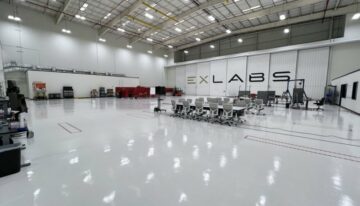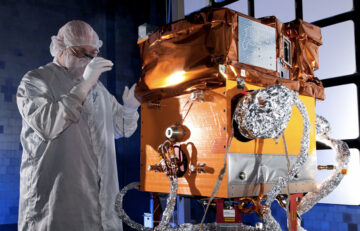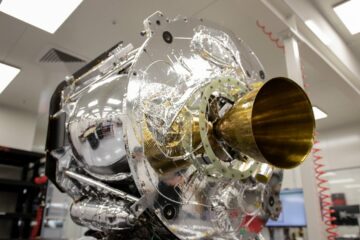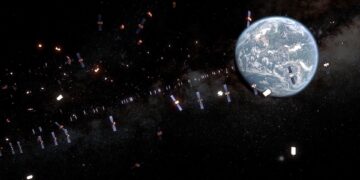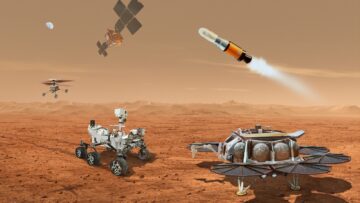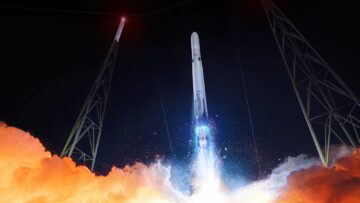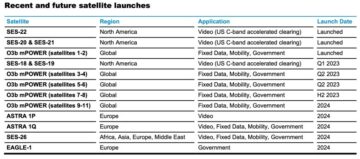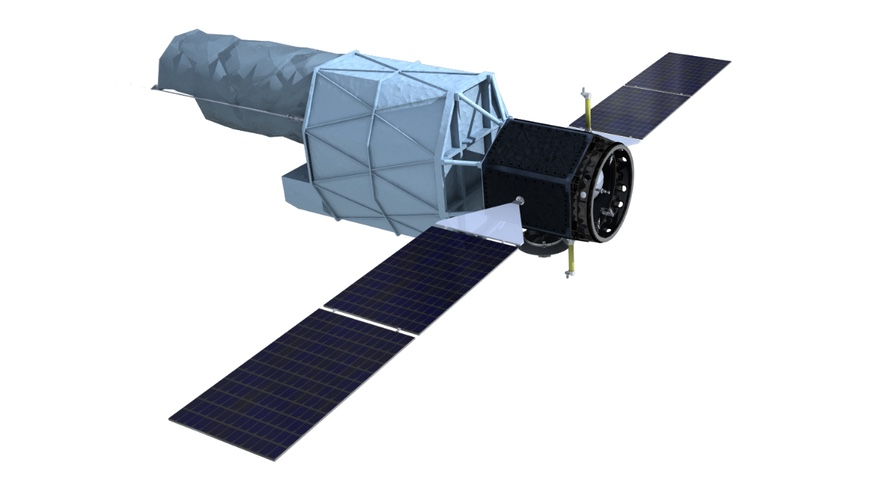
TITUSVILLE, Fla. — NASA has selected an ultraviolet observatory for development but will delay its launch by two years because of budget challenges.
NASA announced Feb. 13 that it chose the Ultraviolet Explorer, or UVEX, spacecraft as its next astrophysics Medium-class Explorer mission. The spacecraft will perform an all-sky survey at ultraviolet wavelengths and be able to identify ultraviolet sources of energetic events like neutron star mergers that create bursts of gravitational waves.
“NASA’s UVEX will help us better understand the nature of both nearby and distant galaxies, as well as follow up on dynamic events in our changing universe,” Nicola Fox, NASA associate administrator for science, said in a statement about the mission’s selection.
The $300 million mission will be led by Caltech astronomer Fiona Harrison, who was also the principal investigator on the Nuclear Spectroscopic Telescope Array (NuSTAR) Small Explorer mission that launched in 2012. Other partners on UVEX include the University of California at Berkeley, Northrop Grumman and Space Dynamics Laboratory.
NASA said UVEX will launch in 2030. However, when NASA selected UVEX and another proposal, the Survey and Time-domain Astrophysical Research Explorer (STAR-X) mission, in August 2022 for further study, the agency said the selected mission would fly in 2028.
NASA spokesperson Alise Fisher told SpaceNews Feb. 14 that the two-year delay was linked to budget issues within NASA’s broader astrophysics program. “UVEX has a target launch date of 2030 to allow for an extended phase B to accommodate budget challenges within the Astrophysics Division portfolio,” she said. Phase B covers initial design work on a mission and includes a preliminary design review.
“Extending UVEX’s phase B allows us to prioritize missions already in development so that NASA can still fully support them, while also supporting the innovative UVEX concept,” she said.
The former director of NASA’s astrophysics division, Paul Hertz, warned of such a delay in July 2022, citing reduced budgets then projected for fiscal year 2023. That would mean, he said then, having the mission spend more time in Phase B to slow its spending ramp-up, delaying its launch.
At the same time NASA picked UVEX and STAR-X for additional study, the agency also selected two other projects as missions of opportunity, less expensive alternatives that often involve flying a payload on another spacecraft or the International Space Station. One, Moon Burst Energetics All-sky Monitor (MoonBEAM), would have flown a gamma-ray instrument in cislunar space on a smallsat similar to NASA’s Lunar Trailblazer spacecraft. The other, A Large Area burst Polarimeter (LEAP), would have studied gamma-ray bursts using an instrument on the ISS.
When NASA selected LEAP and MoonBEAM for further study, the agency said it would pick one of the missions, with an $80 million cost cap, for flight by 2027. However, the agency selected neither mission for development, which NASA again said was based on budget pressures.
“After detailed review by a panel of scientists and engineers, and after evaluation based on NASA’s current astrophysics portfolio coupled with available resources, NASA declined to select a Mission of Opportunity to continue into development,” Fisher said. “NASA is in a constrained and uncertain budgetary environment that necessitates thoughtful consideration of plans and activities for all future missions, while also ensuring a balanced portfolio.”
NASA officials have warned of budget pressures on the agency in general, including its astrophysics programs. In October, Mark Clampin, current director of the agency’s astrophysics division, said cuts in the budgets for the Hubble Space Telescope and Chandra X-Ray Observatory were being considered in response to funding levels for fiscal year 2024 expected to be no higher than what the agency received in 2023.
At a NASA town hall meeting during the American Astronomical Society meeting Jan. 8 in New Orleans, Clampin said he was working to prioritize missions in their prime operations phases, like the James Webb Space Telescope, as well as continued development of the Roman Space Telescope and early work on another flagship telescope, the Habitable Worlds Observatory. Astrophysics research and analysis grants would also be protected, he said.
That approach, he said, would ensure a balanced portfolio across astrophysics. “We’re still extremely well-funded. We have a lot of great missions that are operating and we have a lot of great programs that are moving forward,” he said. “I kind of look at this as a glass half-full. There’s a lot of opportunity here for both current astrophysics and future astrophysics generations.”
- SEO Powered Content & PR Distribution. Get Amplified Today.
- PlatoData.Network Vertical Generative Ai. Empower Yourself. Access Here.
- PlatoAiStream. Web3 Intelligence. Knowledge Amplified. Access Here.
- PlatoESG. Carbon, CleanTech, Energy, Environment, Solar, Waste Management. Access Here.
- PlatoHealth. Biotech and Clinical Trials Intelligence. Access Here.
- Source: https://spacenews.com/nasa-selects-ultraviolet-astronomy-mission-but-delays-its-launch-two-years/
- :has
- :is
- $UP
- 13
- 14
- 2012
- 2022
- 2023
- 2024
- 2030
- 8
- a
- Able
- About
- accommodate
- across
- activities
- Additional
- After
- again
- agency
- All
- allow
- allows
- already
- also
- alternatives
- American
- an
- analysis
- and
- announced
- Another
- approach
- ARE
- AREA
- Array
- AS
- Associate
- astronomy
- astrophysics
- At
- AUGUST
- available
- b
- balanced
- based
- BE
- because
- being
- Berkeley
- Better
- both
- broader
- budget
- Budgets
- but
- by
- california
- CAN
- cap
- challenges
- changing
- chose
- citing
- concept
- consideration
- constrained
- continue
- continued
- Cost
- coupled
- covers
- create
- Current
- Date
- delay
- delays
- Design
- detailed
- Development
- Director
- Distant
- Division
- during
- dynamic
- dynamics
- Early
- energetic
- Engineers
- ensure
- ensuring
- Environment
- evaluation
- events
- expected
- expensive
- explorer
- extended
- extremely
- Feb
- fiona
- Fiscal
- fla
- flagship
- flight
- flying
- follow
- For
- Former
- Forward
- fox
- fully
- funding
- further
- future
- Galaxies
- General
- generations
- glass
- grants
- gravitational
- Gravitational waves
- great
- Hall
- Have
- having
- he
- help
- here
- hertz
- higher
- However
- HTTPS
- Hubble
- Hubble Space Telescope
- identify
- in
- include
- includes
- Including
- initial
- innovative
- instrument
- International
- international space station
- into
- involve
- ISS
- issues
- IT
- ITS
- james
- James Webb Space Telescope
- Jan
- jpg
- July
- Kind
- laboratory
- large
- launch
- launched
- Leap
- Led
- less
- levels
- like
- linked
- Look
- Lot
- Lunar
- mark
- mean
- meeting
- mergers
- million
- Mission
- missions
- Monitor
- Moon
- Moonbeam
- more
- moving
- Nasa
- Nature
- necessitates
- Neither
- Neutron star
- New
- New Orleans
- next
- no
- nuclear
- observatory
- october
- of
- officials
- often
- on
- ONE
- operating
- Operations
- Opportunity
- or
- orleans
- Other
- our
- panel
- partners
- Paul
- perform
- phase
- phases
- pick
- picked
- plans
- plato
- Plato Data Intelligence
- PlatoData
- portfolio
- preliminary
- pressures
- Prime
- Principal
- Prioritize
- Program
- Programs
- projected
- projects
- proposal
- protected
- received
- Reduced
- research
- Resources
- response
- review
- roman
- Said
- same
- Science
- scientists
- select
- selected
- selection
- she
- similar
- slow
- small
- So
- Society
- Sources
- Space
- space station
- space telescope
- spacecraft
- SpaceNews
- spend
- Spending
- spokesperson
- Star
- Statement
- station
- Still
- studied
- Study
- such
- support
- Supporting
- Survey
- Target
- telescope
- than
- that
- The
- their
- Them
- then
- this
- time
- to
- told
- town
- Town Hall
- trailblazer
- two
- Uncertain
- understand
- Universe
- university
- University of California
- us
- using
- warned
- was
- wavelengths
- waves
- we
- WELL
- were
- What
- when
- which
- while
- WHO
- will
- with
- within
- Work
- working
- world’s
- would
- x-ray
- year
- years
- zephyrnet

